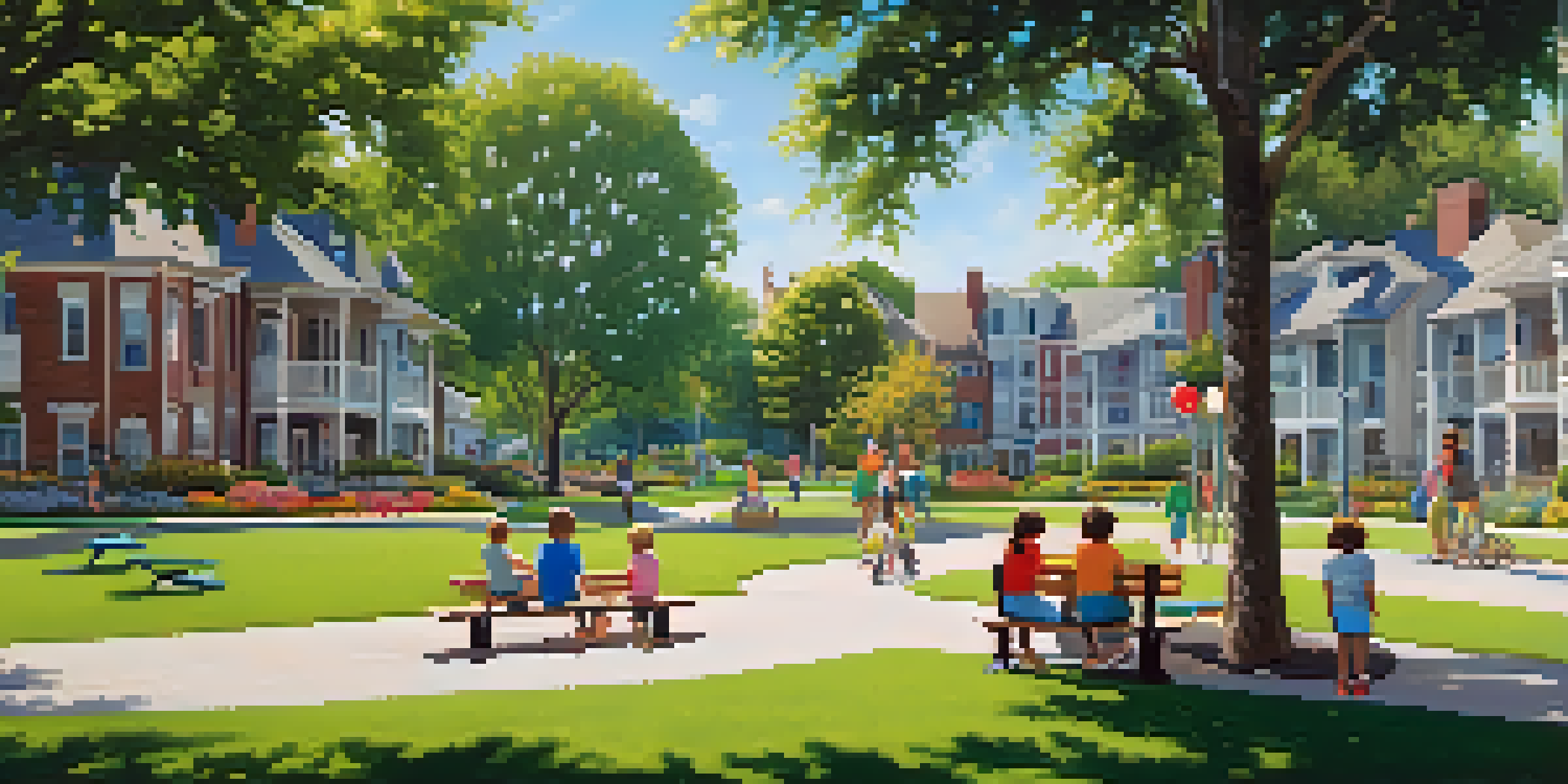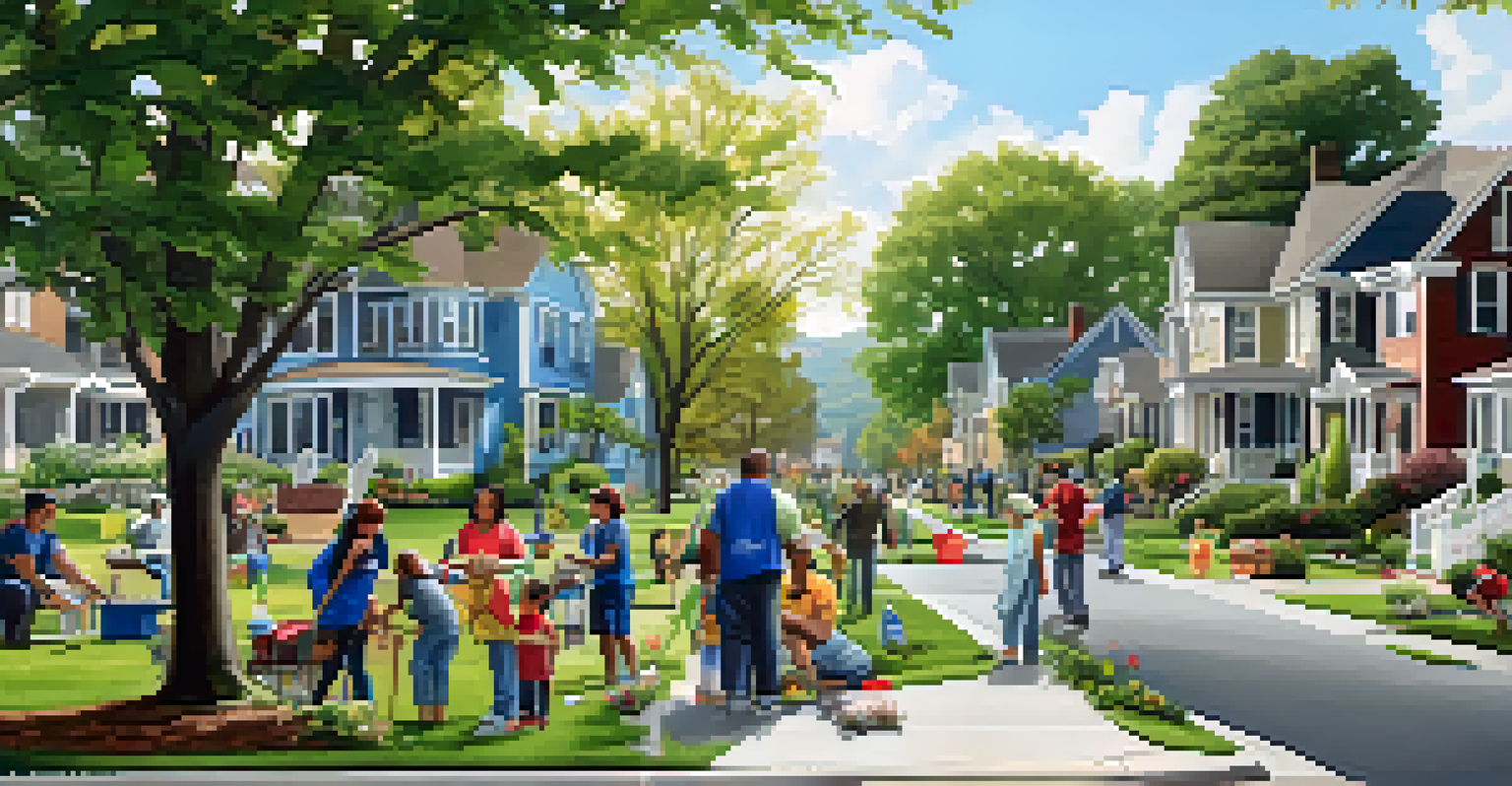The Role of HOAs in Maintaining Community Standards

Understanding What HOAs Are and Their Purpose
Homeowners' Associations (HOAs) are organizations in residential communities that enforce rules and regulations. These associations are typically formed to maintain the shared spaces and to ensure that the community adheres to specific standards. In essence, HOAs exist to protect property values and enhance the living experience for all residents.
A community is like a ship; everyone ought to be prepared to take the helm.
One of the primary purposes of HOAs is to maintain common areas, such as parks, pools, and landscaping. By ensuring these spaces are well-kept, HOAs contribute to a pleasant environment that residents can enjoy. This maintenance not only boosts community aesthetics but also fosters a sense of pride among homeowners.
Additionally, HOAs set guidelines regarding property modifications, noise levels, and even pet ownership. These rules help create a harmonious living environment where residents can coexist peacefully. Understanding the role of HOAs is crucial to appreciating how they contribute to community standards.
How HOAs Enforce Community Rules Effectively
HOAs enforce community rules through a structured approach that includes regular inspections and communication with residents. They often have dedicated committees responsible for monitoring compliance with the established guidelines. This proactive stance helps identify issues before they escalate, maintaining the community's standards.

Residents are usually provided with a handbook detailing the rules and regulations, ensuring clarity on what is expected. Regular meetings and newsletters also play a vital role in keeping everyone informed and involved. When residents understand the rules, they’re more likely to adhere to them, creating a cooperative community spirit.
HOAs Maintain Community Standards
Homeowners' Associations enforce rules and maintain common areas to enhance property values and improve the living experience for residents.
If violations occur, HOAs typically follow a systematic process to address them, which may include warnings or fines. This structured enforcement ensures fairness while encouraging compliance. By taking these steps, HOAs reinforce the importance of community standards and foster accountability among residents.
The Benefits of Living in an HOA Community
Living in an HOA community comes with numerous benefits that enhance the overall quality of life. One of the most significant advantages is the assurance that the neighborhood will be well-maintained, which can lead to increased property values. Homeowners often find comfort in knowing that their investment is protected.
The secret to a happy community is not in the absence of conflict, but in the presence of effective communication.
Additionally, HOAs foster a sense of community by organizing events and activities that bring residents together. From holiday celebrations to community clean-up days, these initiatives encourage interaction and build relationships among neighbors. This sense of belonging can make a neighborhood feel more like home.
Moreover, HOAs often provide access to amenities that might be difficult for individual homeowners to manage on their own. Features like swimming pools, fitness centers, and sports courts can enhance leisure activities, making the community more attractive. These shared resources emphasize the value of living in an HOA-managed environment.
Common Misconceptions About HOAs
Many people hold misconceptions about HOAs, often viewing them as overly strict or controlling. While it's true that HOAs enforce rules, their primary goal is to maintain community standards, which ultimately benefits everyone. Understanding this can help alleviate fears and foster a more positive view of these organizations.
Another common myth is that HOAs are only concerned with aesthetics, neglecting the needs of residents. In reality, many HOAs prioritize safety and community well-being alongside appearance. They may implement policies that address issues like noise control or parking regulations, ensuring a balanced approach to governance.
Effective Communication is Key
Regular updates and open channels for feedback are essential for fostering trust and collaboration within an HOA community.
Finally, some residents believe that they have no say in HOA decisions. However, most associations encourage open communication and feedback from homeowners. Regular meetings and voting opportunities allow residents to participate actively in shaping their community, proving that HOAs can indeed be democratic in nature.
The Role of Communication in HOA Success
Effective communication is vital to the success of any HOA. Regular updates through newsletters, emails, or community boards keep residents informed about rules, upcoming events, and maintenance schedules. This transparency fosters trust and encourages a collaborative atmosphere within the community.
Moreover, open lines of communication make it easier for residents to voice concerns or suggestions. Many HOAs establish channels for feedback, such as suggestion boxes or dedicated email addresses. This approach not only empowers residents but also gives the HOA valuable insights into community needs and preferences.
Furthermore, when communication is prioritized, conflicts can often be resolved more smoothly. Residents are more likely to address issues before they escalate if they feel heard and understood. This creates a more harmonious living environment, reinforcing the HOA's role in maintaining community standards.
Challenges HOAs Face in Maintaining Standards
Despite their best efforts, HOAs can face numerous challenges in maintaining community standards. One of the main hurdles is resident compliance; not everyone may agree with the rules or see their value. This can lead to tensions and disputes, making it difficult for the HOA to uphold its standards effectively.
Additionally, financial constraints can limit the ability of HOAs to carry out necessary maintenance or improvements. Many associations rely on fees collected from residents, and if these funds are insufficient, essential services may suffer. This can impact the overall appeal and functionality of the community.
Challenges in HOA Management
HOAs face difficulties such as resident compliance and financial constraints, which can hinder their ability to uphold community standards.
Lastly, changes in community demographics can pose challenges for HOAs. As neighborhoods evolve, so do the needs and desires of residents. HOAs must adapt their rules and initiatives to reflect these changes, which can require significant effort and resources. Balancing tradition with modern needs is crucial for ongoing success.
The Future of HOAs and Community Standards
As communities continue to evolve, the future of HOAs will likely hinge on their ability to adapt to changing resident expectations. Embracing technology, such as online platforms for communication and payment, can streamline operations and enhance engagement. This modernization can make it easier for residents to connect with their HOA and participate in community decisions.
Sustainability is also becoming a significant focus for many HOAs. Residents are increasingly interested in eco-friendly practices, from landscaping to waste management. HOAs that prioritize green initiatives will not only meet the desires of their residents but also contribute positively to the environment.

Ultimately, the future of HOAs will depend on their commitment to inclusivity and responsiveness. By listening to residents and being open to change, HOAs can maintain their vital role in upholding community standards while fostering a sense of belonging and pride among homeowners.